









The settlement of Gladkovskaya in the Krymsk district, Krasnoyarsk region, was founded as the khutor of Novo-Blagoveshchenskiy in 1899 and settled by the inhabitants of Blago-veshchenskiy for land utilization (today the settlement of Blagoveshchenskaya). Who uttered the wish to cultivate this new territory (forest soil), was discharged from Cossack duty. The people settled down in sheds, rooted out and cleared the land, built farms, tilled the soil and laid out melon fields, gardens and vineyards. Until today there still exists the first Cossack house of Alexey Ivanovich Gladkiy, who established himself here as one of the first settlers of the Gladkiy family. On a huge square, edged by trees, they built a church and a school, set up market stands, organized fun fairs, brought over roundabouts and carried out horse examinations. There was an administration building and two stores. The settlement had two names - one after the Gladkiy's family name, and the second came off as follows: before the colonization of this area there lived a forester named Gladkiy, a namesake, who sank a well, which remained the only water supply for the settlement for many decade. It was situated in a deep gorge. Today numerous hydrants can be found in the settlement, but those inhabitants, who do not live too far away, come and get their water from this wonderful well.
Not later than 1912 the khutor of Novo-Blagoveshchenskiy became the settlement of Glad-kovskaya. In all probability, Fedot Vassilyevich Luzan held the position of the first ataman; from what the settlers remember he filled this duty for a very long time.
Before the revolution the settlement consisted of 200 farmsteads.
The second ataman was Ivan Alexeyevich Gladkiy - Alexey Ivanovich's son. During the years of the revolution, this is what some settlers recall, "he harnessed some good horses to the carriage, had his wife and four children climb on it and went off to the town of Novorossiysk. He left behind his farm and the complete furnishings. This saved him and his family from all the evil which hit the place with the appearance of the Soviet power.
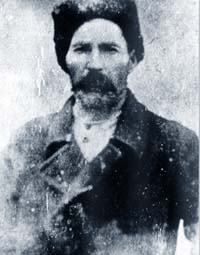 The last ataman, for only a few months, however, was Ivan Kondratovich
Gladkiy, a nephew of Alexey Ivanovich. He was one of the first, who settled down
in a shed - together with his wife Maria Pavlovna and his son Semyon, who was
about one year old. During his term of office General Pokrovskiy visited the
settlement and the Cossacks gathered for a meeting; but one problem in
connection with the land could not be solved. They quit their Cossack duty, went
apart and set off for home. This is what the settlers reported.
The last ataman, for only a few months, however, was Ivan Kondratovich
Gladkiy, a nephew of Alexey Ivanovich. He was one of the first, who settled down
in a shed - together with his wife Maria Pavlovna and his son Semyon, who was
about one year old. During his term of office General Pokrovskiy visited the
settlement and the Cossacks gathered for a meeting; but one problem in
connection with the land could not be solved. They quit their Cossack duty, went
apart and set off for home. This is what the settlers reported.
And after the revolution Ivan Kondratovich lived in the settlement in his farmstead, with three daughters and a son; two sons had already left their parents' house and lived with thier families in the same settlement, and one of the daughters was married to a local settler. Son Vladimir stayed to live there until the end of his life, the two daughters, Vassilissa and Anastassia still live in the settlement; they never changed the place of residence.
 In 1929, considered as a culack, Ivan Kondratovich was dispossessed, arrested
and executed in the town of Novosibirsk; his family was chased out of their
house. The official clerk of the settlement at that time was Denis Matveyevich
Trushchenko.
In 1929, considered as a culack, Ivan Kondratovich was dispossessed, arrested
and executed in the town of Novosibirsk; his family was chased out of their
house. The official clerk of the settlement at that time was Denis Matveyevich
Trushchenko.
During the short historic period of the existence of the settlement its inhabitants were hit by a lot of misfortune. In pre-revolutionary times a group of Greens (partisans) was founded in the settlement, consisting of a few settlers and some villagers from the surrounding areas; this group was called gang or band. They were ordered to massacre all inhabitants of the settlement, but those were saved either by fear or Providence, as they later reported. No matter from which direction the enemy tried to get into the settlement, there were walls everywhere. One member of the gang yet spared no effort to divert his comrades from carrying out their plans. While they were still quarreling it began to dawn - and thus the settlers stayed alive.
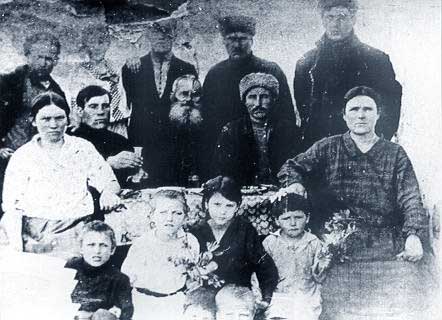
In 1918, following an official appeal, the young and some older Cossacks left for the settlement of Slavyanskaya (today the city of Slavyansk). Their way lead them through the settlement of Varenikovskaya, from where they crossed the river Kuban by means of a wooden ferry. On their way back they had a clash with the Greens in the Shtelmakhovaya gorge; most probably they were lured into the only farm there and then executed; they also had no pity with Yermolenko's wife, who had left home to search for her husband, as well as his seven-year-old son from the first marriage. And these are the family names of the executed:
The following persons miraculously survived:
1. Kochubey, Fyodor, 2. Smaglyuk, Savva, 3. Chub, Savva.
They had not taken the way on the road, but had chosen a narrow trail.
For a few days they searched for the draftees, then they found their dead bodies, which had already changed into putrescence. They were buried in one single grave within the enclosure of the search yard.
In 1921 a punitive detachment of the Reds arrived and arrested many Cossacks; some they let off, among them the former ataman of the settlement, Ivan Kondratovich Gladkiy.
12 people, among them one woman, were executed. Their family names are:
During the day a grave was dug behind the Cossack settlement, in the birch grove, and there they were executed.
That happened in October - a dark night, it rained heavily, but a few inhabitants saw, how hey were lead behind the settlement, tied together in twos.
After about one and a half months the relatives received the permission to transfer the corpses to the cemetery and lay them to eternal rest. When they opened the grave all the dead bodies looked as if they were jellied, and they also discovered that Yevmen Sitnik did not even have a bullet wound, but had obviously given screams - finish off, kill me finally - but the punitive troups merely shot into the grave at random, filled it up and went away.
Then, in 1929, followed the dekulakization. Much has been written about it. In 1933 - the hunger period. The people in the Cossack setttlement ran about with bloated bellies. only a few died. Parts of the nourishment could be found in the woods and on the ground.
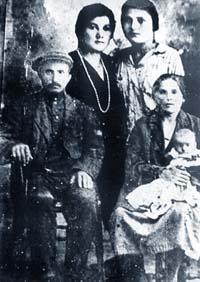 The church was closed in 1931; during the night all the interior decoration
was loaded on rack waggons and transported away to the Cossack settlement of
Krymskaya, which is today the city of Krymsk. One night they took away the
church bell, but even though they treated it with utmost care, it nevertheless
gave a loud sound from time to time. The people heard it and started praying. In
the spring of 1934 the cross was removed and - to be precise - this was done by
the very same man, who had placed it there, when the church had still been under
construction - Stepan Gudko (the father).
The church was closed in 1931; during the night all the interior decoration
was loaded on rack waggons and transported away to the Cossack settlement of
Krymskaya, which is today the city of Krymsk. One night they took away the
church bell, but even though they treated it with utmost care, it nevertheless
gave a loud sound from time to time. The people heard it and started praying. In
the spring of 1934 the cross was removed and - to be precise - this was done by
the very same man, who had placed it there, when the church had still been under
construction - Stepan Gudko (the father).
All the inhabitants of the Cossack settlement streamed out of their houses to the church square; some watched in silence, others made the sign of the cross. When the cross crashed to the ground a scream of despair was heard. And we, the omnipresent children, watched all this.
In the church building they opened a club, but nobody went there. In the autumn of 1934 they transported a brown bear to the spot. Amessenger informed the whole Cossack settlement that a free bear show would take place, and almost everybody from the settlement and the khutor, but particularly young people, rushed there to see what would be going on. After the show they organized a dance. Many went there and thus, finally, a club opened in the former church.
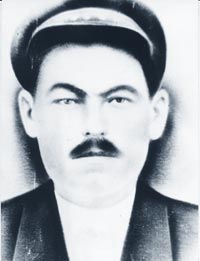 During the occupation the Germans used the church as a horse stable, after
the war it served as a granary to the kolkhoz. Late in the 1950s the church was
completely pulled down and on the square of the former churchyard they built a
couple of houses with little sheds for the cattle. On the remaining open space
they planted poplars. During the occupation there was a German cemetery around
the church; when the soldiers withdrew, the crosses were removed and the graves
levelled, but the caved in ground remained visible for a long time. Around the
Cossack settlement there were many German cemeteries.
During the occupation the Germans used the church as a horse stable, after
the war it served as a granary to the kolkhoz. Late in the 1950s the church was
completely pulled down and on the square of the former churchyard they built a
couple of houses with little sheds for the cattle. On the remaining open space
they planted poplars. During the occupation there was a German cemetery around
the church; when the soldiers withdrew, the crosses were removed and the graves
levelled, but the caved in ground remained visible for a long time. Around the
Cossack settlement there were many German cemeteries.
In 1935 several families were deported from all Cossack settlements in the Kuban region. In our settlement four families were hit by this deportation:
They were deported to the Krasnoyarsk region. Quite a few later returned home.
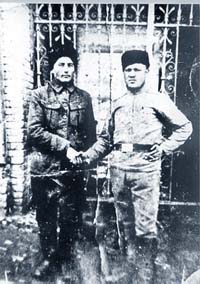 Semyon Ivanovich Gladkiy and Fyodor Kuzmich Kochubey were arrested in May
1938; on the 31st of Augsut of the same year they were executed in the city of
Yenisseysk. Meanwhile they have been rehabilitated.
Semyon Ivanovich Gladkiy and Fyodor Kuzmich Kochubey were arrested in May
1938; on the 31st of Augsut of the same year they were executed in the city of
Yenisseysk. Meanwhile they have been rehabilitated.
From 1936 to 1938 two big fires broke out in the Cossack settlement; in the first fire a drying kiln and a tobacco elevator burned down, in the second a new barn for cattle raising. The culprits were never found; but it was suspected that the buildings were set on fire by activists, as an act of revenge, because they had not been elected into leading positions.
The kolkhoz farmers in the Cossack settlement lead a miserable life; there were no clothes, no shoes, and high taxes were imposed on them - meat deliveries to the State and loans.
In the years before the war the villages were extended; many solitary farms became inegrated in the Cossack settlement; there were many young people, who used to meet on the square in the evening, on Sundays, where they sang songs and danced to the sounds of an accordion.
In 1941 the war broke out, many settlers died - at the front, as prisoners of war in German or Soviet camps. Peacable villagers died at home, because this was where the so-called Blue Line went past, a small strip of land, not far from Novorossiysk, which a small group of Red Armists had occupied during the war. The Cossack settlement remained under occupation for a period of 15 months, 10 of which passed by with permanent fighting; the people spent the whole time in trenches, grew ill, the cildren suffered from vitamin deficiency. Many lost the roof over their head, all their belongings, their cattle, and the houses made of stone were pulled down by the Germans, since they needed the stones for the construction of roads.
In the woods there were Soviet ground forces; they took two Germans prisoners of war and executed them on the village square. The people living nearby heard their groaning in agony.
After the war mine-clearing parties worked in that place. They collected the mines and projectiles which lay scattered around, in order to deactivate them; with many they were successful, but in some cases their work came to a tragic end.
Those who returned from war took their families and went away to the town, mainly to Novorossysk. The Cossack settlement depopulated. The school was closed, the pupils taken to the neighbouring village. Today the settlement disposes of a post-office, a store, a sovkhoz brigade, an infirmary and a little office room for the responsible of cultural work among the masses.
Today the settlement is also provided with electricity, disposes of radios, TV sets in many houses, refrigerators, and, upon good weather, busses are going regularly.
However, there are only few young families, most of the inhabitants are old people. Behind the Cossack settlement, on the river Psebeps, there is an artificial lake, where they do fish-farming.
In the 1950s the settlers experienced the aftereffects of the war, and this is how it happened:
a girl, who had been living in the district during the occupation, was sent to Moscow (after having grown up) to an exhibition about the achievements of national economy. There she suddenly noticed a man who had served for the militia or the rural policy. She reported this and he was immediately arrested. And then he betrayed another two former comrades. They lead him through the Cossack settlement and its surroundings in handcuffs, where they had formerly executed peaceful inhabitants. When they were asked, why all the cildren's bones lay right at the bottom and those of the adults on top, they replied - that the children had been shot first to avoid them screaming; then the corpses were piled up, always one with his head at the feet of the next, so that as many as possible would fit into the grave. On the village square they boiled water in kettles, washed the mortal remains and buried them in coffins on the cemetery. And the whole time an orchestra of wind instruments was playing funeral music. The settlers even today remember this cruel and horrible time; on the cemetery a monument has been erected -a mother protectingly leaning over her children.
In 1989 the Cossack settlement celebrated its 90th anniversary and the eldest inhabitant, Vassilissa Ivanovna Filin, born on the 19th of January 1903, who has just finished the 90th year of her life, was handed over a gift. She is my godmother on my father's side. The only person bearing the name of the Gladkiys' is Anna Dmitriyevna Gladkaya, the wife of my deceased uncle Vladimir Ivanovich Gladkiy.
In 1992 construction workers arrived from Mangyshlak and Surgut; there exist plans to build a comfortable home for workers, who live already on pension. And they intend to revive the Cossack village of Gladkovskaya.
I wrote down these remembrances in accordance with what my deceased mother, Olga Matveyevna Gladkaya (Trushchenko), as well as close relatives, told me and completed them with what I was able to recall myself.
For me the settlement of Gladkovskaya is the loveliest spot in whole Russia, I am longing for it and, if possible, I would like to visit it.
Written by Antonina Semyonovna Gladkaya-Poplyukova, the second daughter of Semyon Ivanovich Gladkiy and the second grand-daughter of Ivan Kondratovich Gladkiy, the last ataman of the Cossack village of Gladkovskaya.
February 1993.